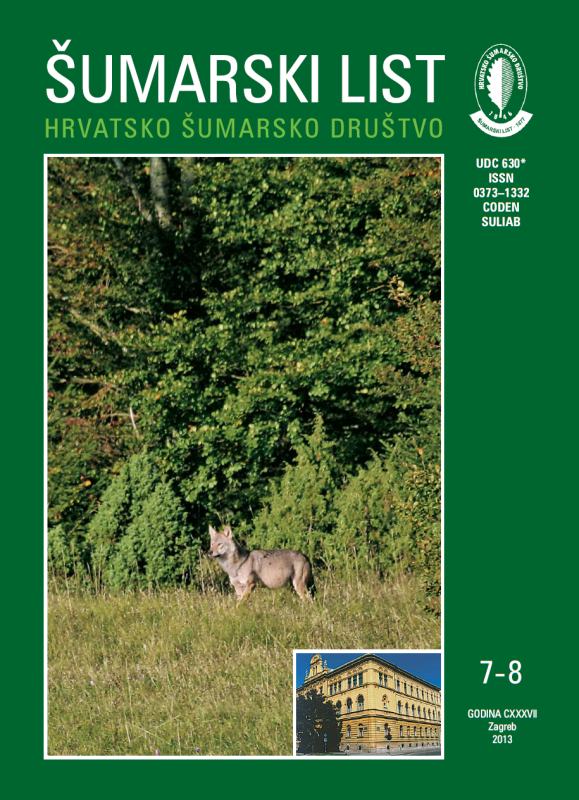
broj: 7-8/2013
pdf (5,06 MB) |
|
||||||||||||||
| RIJEČ UREDNIŠTVA | ||
| Uredništvo | ||
| DO FORESTRY PRACTICES DISREGARD THE PRINCIPLES OF SUSTAINABLE FOREST MANAGEMENT? pdf HR EN | 365 | |
| IZVORNI ZNANSTVENI ČLANCI | ||
| Krunoslav Teslak, Jura Čavlović, Mario Božić, Karlo Beljan | UDK 630*228 + 653 (001) | |
| PEDUNCULATE OAK (Quercus robur L.) TREES QUALITATIVE STRUCTURE AS A CRITERIA OF THE STAND REGENERATION PLANNING pdf HR EN | 367 | |
| Miroslav Balanda, Ján Pittner, Milan Saniga, Ján Jaďuď, Lucia Danková, Marián Ďuriš | UDK 630*815 + 612 * (Picea abies L. Karst) (001) | |
| STAND DYNAMICS OF THE SUBALPINE SPRUCE (Picea abies L. Karst) FOREST – A DISTURBANCE DRIVEN DEVELOPMENT pdf HR EN | 379 | |
| Dimitrios N. Avtzis and Dinka Matošević | UDK 630*453 (001) | |
| TAKING EUROPE BY STORM: A FIRST INSIGHT IN THE INTRODUCTION AND EXPANSION OF Dryocosmus kuriphilus IN CENTRAL EUROPE BY mtDNA pdf HR EN | 387 | |
| Oto Nakládal, Petr ŠENFELD, Milivoj FRANJEVIĆ, Hana UhlÍková | UDK 630*453 (001) | |
| COMPARISON OF ALL SEASON AND STANDARD TYPE OF ECOLURE® DISPENSER EFFICACY IN TRAP CATCHES OF EUROPAEAN SPRUCE BARK BEETLE (Ips typographus (L.)) pdf HR EN | 395 | |
| Petra GROŠELJ, Lidija ZADNIK STIRN | UDK 630*629 (001) | |
| BETWEEN COMPROMISE AND CONSENSUS IN GROUP DECISIONS IN FOREST MANAGEMENT pdf HR EN | 403 | |
| Summary: Forest management has become increasingly complex since economic profit became only one of several important management objectives. Considering a diverse set of goals requires the use of multi-criteria decision making. When the only goal was to maximize timber production, the planning process often involved only one decision maker: the forest owner. In the last 20 years, however, planning has changed to include the interests of multiple stakeholders, including local communities, public representatives, hunters, environmentalists, and recreationists, each of which has different knowledge, experiences, prospects, and interests. The formation of a group of stakeholders can be based on participatory planning. The main challenge in group decision making is to resolve the conflict of the group’s objectives and preferences. Aggregating individual preferences is not only a mathematical problem but also a philosophical one. We present the analytic hierarchy process as suitable multi-criteria method, which has been already applied in areas such as forestry and harvest scheduling, biodiversity conservation, regional planning, and forest sustainability. A case study of the forest area at Pohorje, a mountainous area in northern Slovenia, was conducted in order to implement the described theoretical findings. The aim of the study was to select the optimal alternative for Pohorje development. We identified five possible alternatives based on indicators of sustainability. The alternatives were compared by several stakeholders according to the results of a SWOT analysis performed at a workshop of stakeholders, who discussed individual chapters of forest management scenarios. The results of the analysis show that the alternative benefits for people, which takes into account all of Pohorje’s important aspects, is the most appropriate for Pohorje development. Key words: forest management; multi-criteria decision making; analytic hierarchy process; group decision making; compromise; consensus; Pohorje; Slovenia | ||
| STRUČNI ČLANCI | ||
| Alojzije Frković | UDK 630*156 | |
| HUNTING AND HUNTING OPPORTUNITIES IN THE DISTRICT OF SENJ IN THE PERIOD FROM THE 19th TO THE BEGINNING OF THE 20th CENTURY pdf HR EN | 411 | |
| KORICE | ||
| Boris Hrašovec | ||
| Elm bark beetles – important and essential biological factor in Dutch elm disease spread PDF | 440 | |


